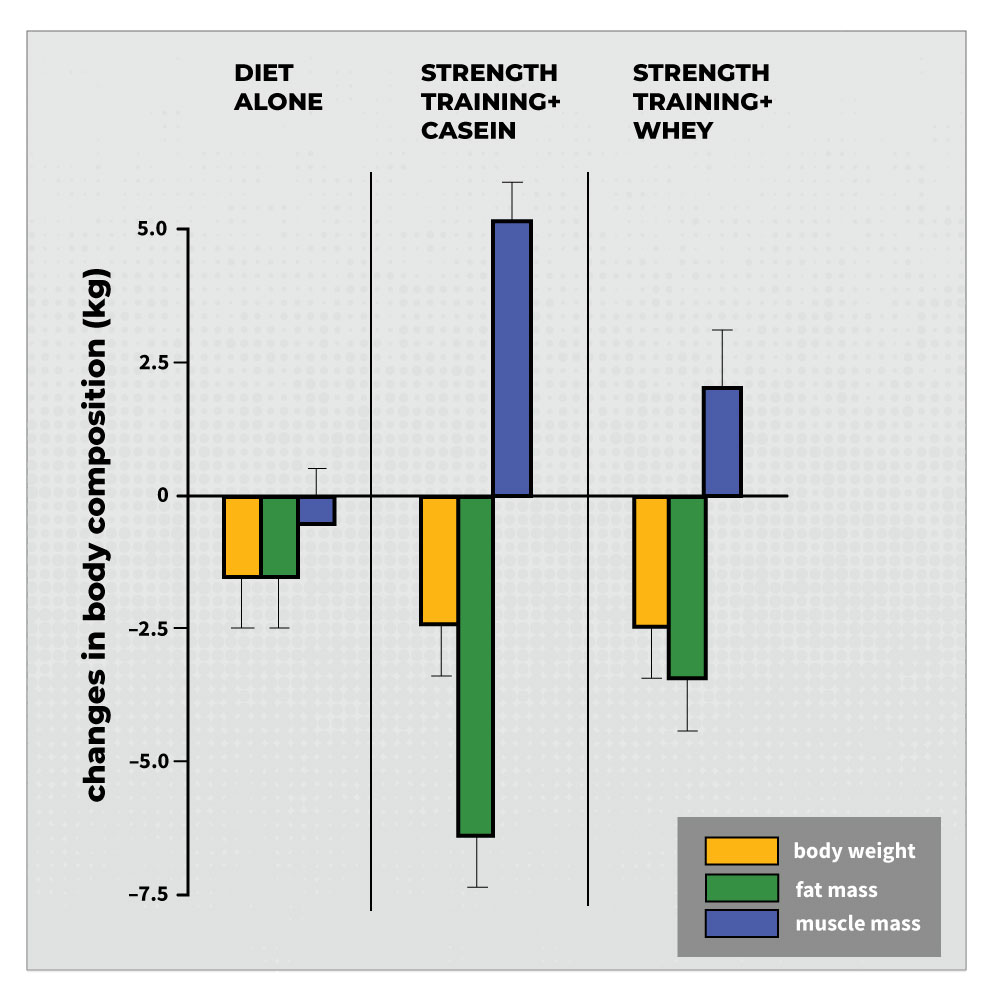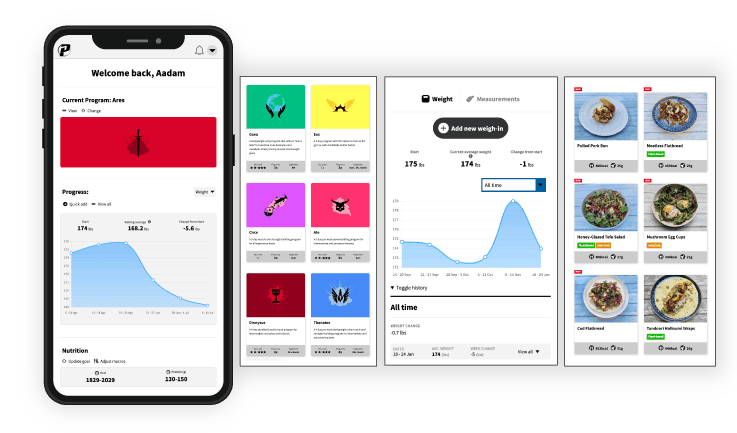A ‘body recomposition’ is the process of maintaining your current body weight while simultaneously losing fat and building muscle.
The reason the body recomposition raises so much confusion is due to the fact you’re trying to accomplish two diametrically opposing goals.
To lose fat, you need to be in a calorie deficit–i.e., eating fewer calories over time so your body can burn body fat. And to build muscle, you need to be in a calorie surplus–i.e., eating more calories than your body needs so it can use the extra calories to build new muscle.
And while it’s possible to do both–build muscle while losing fat–the magnitude to which it will happen depends on the individual. The people most likely to achieve a body recomposition are:
1. Overweight beginners
Everyone’s heard of ‘noob gains’, this magical period in the first 6-12 months of training where you can gain large amounts of muscle mass because your body’s most primed for growth.
Now combine this with excess body fat, and your body has enough energy (body fat) to use for fuel. This combination allows the overweight beginner to simultaneously build muscle while burning fat.
In one study, obese women were put on an 800 kcal/d diet for three months in conjunction with strength training and lost 35lbs while seeing an increase in muscle fiber cross-sectional area.
Another 12-week study by Demling and DeSanti, (2000) split untrained, overweight men into three groups:
- Group 1: Diet alone
- Group 2: Diet + high-protein (casein) + resistance training
- Group 3: Diet + high-protein (whey) + resistance training
The protein and strength training groups gained muscle and strength while losing body fat.

And Longland et al. found gains in lean mass in overweight male subjects who were new to weight training despite eating in a 40% energy deficit.
2. Detrained individuals
Someone who’s taken time off training (e.g., due to injury) will find they can drop body fat and build muscle very quickly once they start training again. But they’re not gaining new muscle, they’re just gaining back the muscle they lost during the layoff.
3. People who are on that ‘special sauce’ and/or have great genetics
This is pretty obvious so we don’t need to waste time discussing this.
With that said, I think in most instances for most people a body recomposition is probably not worth the time or effort
Yeah, yeah, I know. This is an article on how to body recomposition so I’m supposed to share some super secret protocol to help you achieve it.
But the truth is, there is no secret nor is there any magic to the recomp. And, outside of a few cases (which I’ll discuss below), the body recomposition is pretty pointless for the majority of people.
For example, an overweight beginner would be better off eating in a moderate calorie deficit (in conjunction with weight training) because they’ll see progress faster than trying to recomp.
Similarly, If you’re a lean beginner trying to gain muscle, eating in a moderate calorie surplus is going to be far more productive than trying to gain muscle while staying as lean as you can.

This doesn’t mean the body recomposition is totally pointless, there are some people who can benefit from it.
Who would benefit from a body recomposition?
1. The ‘skinny-fat’ beginner
Someone who is ‘skinny-fat’ has low levels of muscle mass and moderate-to-high levels of body fat, particularly around the stomach.
A calorie deficit will only make them look worse as they lack the muscle to look lean. So a body recomposition will be a better option.
2. People who need to stay lean year ’round
If you need to stay lean all the time–for example, you’re a model–you can’t afford extended periods of bulking and cutting.
Recomping makes it easier to keep a photo-ready physique while making consistent muscle and strength gains.
3. You have hang-ups around gaining body fat
If you need to gain muscle but have anxiety around gaining body fat, using a body recomposition approach can offer some psychological relief. Just be aware your progress will be slower using this approach than if you were eating in a moderate surplus.
Note: If you’re a lean/skinny beginner, you shouldn’t use this approach because you’ll miss out on maximising your muscle and strength gains. You should be eating in a calorie surplus and using a training program that utilises progressive overload. But, as always, this is just my advice and I’m not your dad–so do whatever the fuck you want.
4. You want to ‘gaintain’
If you’re happy with where you are and don’t care about cutting or bulking, then you can use the recomp approach I’ll be laying out below to ‘gaintain’–maintain your current level of conditioning while building muscle and strength.
How to set up your body recomposition diet
Alright, so you’ve decided the body recomposition is the approach for you, this is my recommendation for how to set up your recomp diet.
The recomp diet will follow a calorie cycling approach: you’ll eat in a surplus on training days and in a deficit on rest days while keeping your weekly average calorie intake at maintenance.
Despite what the internet tells you, there’s nothing magic about cycling your calories. The reasons I like to use this approach for a recomposition are:
- By placing more calories on training days you have more energy coming in (i.e., calories) to fuel performance.
- There could be some favourable nutrient partitioning effects by eating more calories on training days–meaning: those extra calories are biased toward muscle and not fat.
- Knowing you can eat more calories a few days per week can help increase adherence versus eating the same amount every day.
Of course, there are individual differences and some people don’t enjoy cycling their calories. If that’s you, then just eat at maintenance throughout the week.
Hate math? Same. So I created a free calculator that will automatically generate your body recomposition diet. You can download it by entering your details into the form below. I’ll also send you my body recomposition training program.
Step 1: find your RMR
To find maintenance, we first need to work out your RMR (resting metabolic rate)–the number of calories you burn at rest.
I like to use the Harris-Benedict formula as it’s the most accurate. Aa
Metric:
- Men: RMR = 66.5 + (13.75 x weight in kg) + (5.003 x height in cm) –(6.755 x age in years)
- Women: RMR = 655.1 + (9.563 x weight in kg) + (1.850 x height in cm) – (4.676 x age in years)
Imperial:
- Men: RMR = 66 + (6.2 x weight in pounds) + (12.7 x height in inches) – (6.76 x age in years)
- Women: RMR = 655 + (4.35 x weight in pounds) + (4.7 x height in inches) – (4.7 x age in years)
Step 2: set your activity factor
Now that you know how many calories you’d burn if you sat on your ass all day, we need to factor in your activity levels.
- Sedentary (little or no exercise): RMR x 1.2
- Lightly active (1-3 days per week of exercise): BMR x 1.375
- Moderately active (3-5 days per week of exercise): BMR x 1.55
- Very active (5-7 days per week of exercise): BMR x 1.725
- Extremely active (physical job + 5-7 days per week of exercise): BMR x 1.9
Once you calculate your RMR and factor in your activity levels, you’ve found your (rough) maintenance intake.
Here are two examples to help illustrate.
Example 1 – Male, 29 years old, 5’10 (70″), 175 lbs, lifts weights 3x per week
First, we need to find his RMR. So we’ll use the formula and replace the relevant sections with the relevant stats (yellow highlights).
66 + (6.2 x 175) + (12.7 x 70) – (6.76 x 29 ) = 1844 kcal/d
Then we need to factor in his activity levels–he lifts 3x per week, so we’ll choose 1.375.
1844 x 1.375 = 2535 kcal/d
➜ Maintenance calories = ~2500 kcal.
Example 2 – Female, 29 years old, 5’6 (66″), 150 lbs, lifts weights 3x per week
First, we need to find her RMR. So we’ll use the formula and replace the relevant sections with the relevant stats (yellow highlights).
RMR = 655 + (4.35 x 150) + (4.7 x 66 ) – (4.7 x 29 ) = 1481 kcal/d
Then we need to factor in her activity levels–she lifts 3x per week, so we’ll choose 1.375.
1481 x 1.375 = 2036 kcal/d
➜ Maintenance calories = ~2000 kcal.
Step 3: work out training and rest day calories
*If you don’t want to cycle calories, then skip this step.
You’ll be eating in a 20% surplus on training days and a 20% deficit on rest days. To work this out, simply add 20% to your maintenance intake on training days and deduct 20% from your maintenance intake on rest days.
Using the male and female from the last section:
Male: maintenance intake is 2500 kcal/d
➜ Training days: 2500 x 0.2 = 500
2500 + 500 = 3000 kcal on training days.
➜ Rest days: 2500 x 0.2 = 500
2500 – 500 = 2000 kcal on rest days
Female: maintenance intake is 2000 kcal/d
➜ Training days: 2000 x 0.2 = 400
2000 + 400 = 2400 kcal on training days.
➜ Rest days: 2000 x 0.2 = 400
2000 – 400 = 1600 kcal on rest days
Step 4: set your macros
Now that you know how many calories you’ll be eating on training and rest days, it’s time to set your macros to optimise your body composition.
- Protein intake: protein intake will remain consistent at 1g/lb
- Fat intake: 0.3-0.6 grams per pound. Go with the higher end if you prefer a high fat diet, and the lower end if you prefer a low fat diet. Or, somewhere in the middle for a more balanced carb/fat intake.
- Carb intake: makes up the remaining calories once protein and fat intakes are set. You’ll be eating more carbs on training days and fewer carbs on rest days.
Here’s what this would look like in our male and female trainees:
Male, 175 lbs.
Training day calories: 3000
• Protein: 175g (because he weighs 175 lbs and we’re setting protein intake at 1 gram per pound of bodyweight)
• Fat: 70g (I set his fat intake at 0.4g/lb of body weight)
• Carbs: 420g (the number of calories remaining after protein and fat are set. For the math on this, see the dropdown below titled ‘how to work out the carb intake’).
Rest day calories: 2000
• Protein and fat stay the same, but his carb intake is reduced to 170g to account for the reduction in calories.
So our male trainee’s recomp diet looks like this:
➜ Training days: 3000 calories, 175g protein, 70g fat, 400g carbs
➜ Rest days: 2000 calories, 175g protein, 70g fat, 170g carbs
-
How to work out the carb intake
Training days:
1) Work out the calories in protein and fats:
Protein: 175 x 4 (because there are four calories in 1 gram of protein) = 700 calories
Fat: 70 x 9 (because there are nine calories in 1 gram of fat) = 630 calories
2) Add the protein and fat calories:
700 (calories from protein) + 630 (calories from fat) = 1330 calories
3) Deduct this number from the total training day calories
3000 (total training day calories) – 1330 (protein and fat calories) = 1670
4) Then divide this number by four (because there are four calories in 1 gram of carbs)
1670/4 = 417.5 grams of carbs (I rounded up to 420g).
• Rest days:
1) subtract the training day calories from the rest day calories
3000 (training day calories) – 2000 (rest day calories) = 1000
2) Then divide by four (remember, four calories in 1 gram of carbs)
1000/4 = 250g carbs
3) Lastly, subtract training day carbs from this number
420 (training day carbs) – 250 = 170g (this is his rest day carb intake)
Female, 150 lbs.
Training day calories: 2400
• Protein: 150g (because she weighs 150 lbs and we’re setting protein intake at 1 gram per pound of bodyweight)
• Fat: 60g (I set her fat intake at 0.4g/lb of body weight)
• Carbs: 315g (the number of calories remaining after protein and fat are set. For the math on this, see the dropdown below titled ‘how to work out the carb intake’.)
Rest day calories: 1600
• Protein and fat stay the same, but her carb intake is reduced to 115g to account for the reduction in calories.
So our female trainee’s recomp diet looks like this:
➜ Training days: 2400 calories, 150g protein, 60g fat, 315g carbs
➜ Rest days: 1600 calories, 150g protein, 60g fat, 115g carbs
-
How to work out the carb intake
Training days:
1) First work out the calories in protein and fats:
Protein: 150 x 4 (because there are four calories in 1 gram of protein) = 600 calories
Fat: 60 x 9 (because there are nine calories in 1 gram of fat) = 540 calories
2) Then add the protein and fat calories
600 (calories from protein) + 540 (calories from fat) = 1140 calories
3) Then deduct this number from the total training day calories
2400 (total training day calories) – 1140 (protein and fat calories) = 1260
4) Then divide this number by four (because there are four calories in 1 gram of carbs)
1260/4 = 315 grams of carbs
Rest days:
1) subtract the training day calories from the rest day calories
2400 (training day calories) – 1600 (rest day calories) = 800
2) Then divide by four (remember, four calories in 1 gram of carbs)
800/4 = 200g carbs
3) Lastly, subtract training day carbs from this number
315 (training day carbs) – 200 = 115g (this is her rest day carb intake)
How to make adjustments during a recomp
The goal of the recomp is to keep your weight pretty much the same (barring some fluctuations) while changes occur in your body composition. Over time you’ll likely be a little heavier due to increased muscle mass.
Below I’ve detailed how to make adjustments for the changes most likely to occur.
- Losing weight? Increase carb intake by 30–50 grams per day.
- Putting on weight and looking softer in the mirror? Reduce carb intake by 30–50 grams per day.
- Putting on weight but looking the same? Leave things as they are.
- Putting on weight, looking bigger but also softer? Reduce carb intake by 20–30 grams per day.
- Losing weight but looking tighter and leaner? Leave thing as they are.
The body recomposition works if you use it correctly and for the right goals
As I mentioned in the article, most people will be better off focusing on building muscle or losing fat. But, if you’ve decided the recomp is something you want to pursue, then follow the guidelines in this article to maximise your progress.
I want to reiterate the body recomposition protocol I’ve laid out isn’t magic and takes time.
Keep your goals in mind and use the recomp as you see fit based on your goals and personal preference.
Don’t forget…
Diet is only one part of a successful body recomposition and without the right training program, you’re going to spin your wheels. In fact, I’d argue one of the main reasons people fail with the recomp is due to sub-optimal programming.
And if you are looking for an effective training program––check out Physiqonomics PLTNM and get access to 80+ training programs you can do at home or at the gym + a bunch of other cool stuff.
Get more details here and start your free 7-day trial to see if it’s for you
